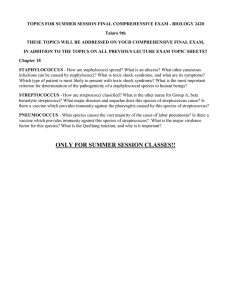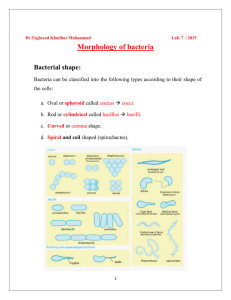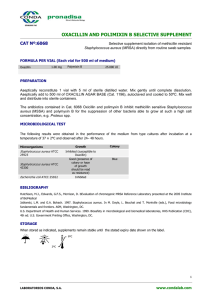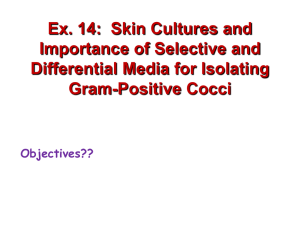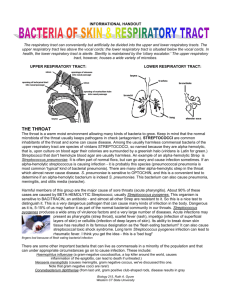Staph and Strept Exams
advertisement
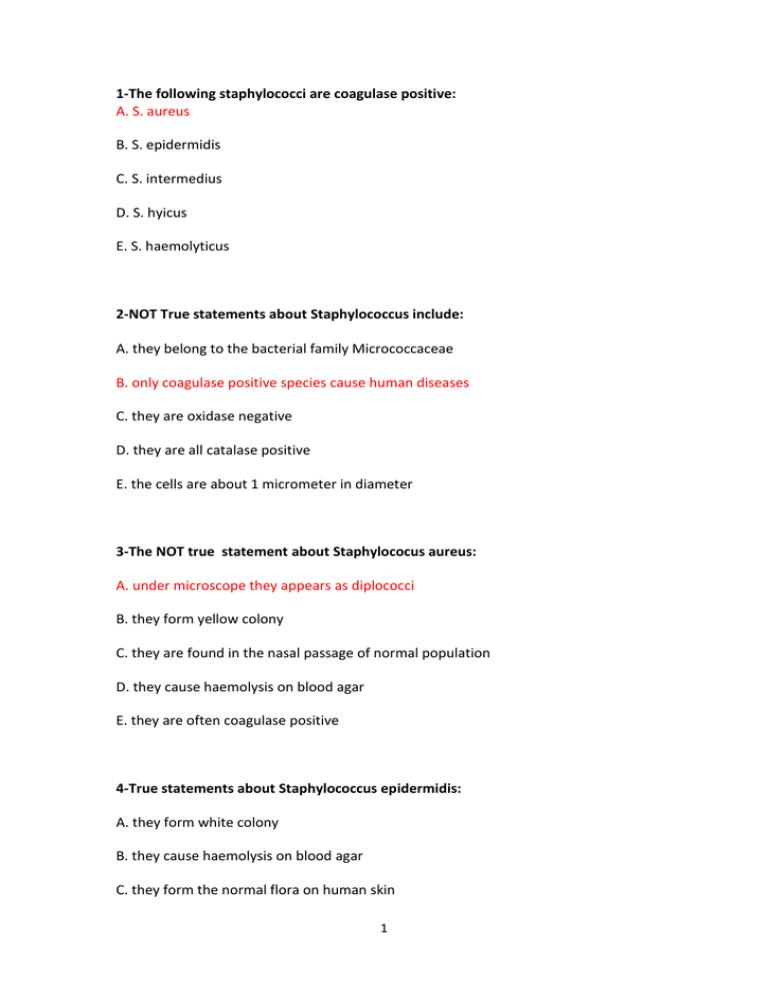
1-The following staphylococci are coagulase positive: A. S. aureus B. S. epidermidis C. S. intermedius D. S. hyicus E. S. haemolyticus 2-NOT True statements about Staphylococcus include: A. they belong to the bacterial family Micrococcaceae B. only coagulase positive species cause human diseases C. they are oxidase negative D. they are all catalase positive E. the cells are about 1 micrometer in diameter 3-The NOT true statement about Staphylococus aureus: A. under microscope they appears as diplococci B. they form yellow colony C. they are found in the nasal passage of normal population D. they cause haemolysis on blood agar E. they are often coagulase positive 4-True statements about Staphylococcus epidermidis: A. they form white colony B. they cause haemolysis on blood agar C. they form the normal flora on human skin 1 D. they are often coagulase positive E. in hospital environment, they can become pathogen 5-The following features can distinguish Staphylococcus from Streptococcus: a. Staphylococcus is Gram positive whereas Streptococcus is Gram negative b. Staphylococcus has round cell whereas Streptococcus has slightly oblong cell. c. Staphylococcus is catalase positive whereas Streptococcus is catalase negative d. Staphylococcus appears as clusters under microscope whereas Streptococcus appears as long chain. e. Staphylococcus divides in two planes whereas Streptococcus divides in one plane only 6-The bacteria which is novobiocin resistant is A.Staphylococcus aureus B. S epidermidis C. S saprophyticus D. None of these 7-Scalded skin syndrome is caused by exotoxin (exfoliatins) produced by: a. Streptococcus pyogens b. Pseudomonas aeruginosa c. Staphylococcus aureus d. Propionibacterium acne e. Demodex folliculorum 8-Burn patients often develop nosocomial infection caused by: a. Streptococcus epidermis b. Corynebacterium spp. c. Staphylococcus aureus d. Candida albicans e. Pseudomonas aeruginosa 2 9-What is the most serious pathogen within the genus Staphylococcus? a.Staphylococcus epidermidis b.Staphylococcus saprophyticus C.Staphylococcus hominis D).Staphylococcus aureus E.Staphylococcus capitis 10-Why is Staphylococcus aureus considered a troublesome hospital pathogen? A.Because its optimum growth temperature is 37°C. B.Because it resists the effects of many disinfectants and antibiotics. C.Because it is a facultative anaerobe. D.Because it grows in large, round opaque colonies. E.Because it can digest proteins and lipids, and ferment a variety of sugars. 11-What is the most diagnostic species characteristic of Staphylococcus aureus? A.The production of hyaluronidase B.The production of penicillinase C.The production of coagulase D.The production of leukocidin E.The production of –toxic 12-Which is not an effect of the Staphylococcus aureus -toxin? A.It acts upon the human gastrointestinal tract. B.It lyses red blood cells of various mammals. C.It causes leukocyte damage. 3 D.It damages skeletal and heart muscle. E.It damages kidney tissues. 13-Staphylococcus aureus is most frequently isolated from what body site? A.Gastrointestinal tract B.Genitourinary tract C.Vagina D.Nostrils E.Stomach 14-What is the most common infection caused by Staphylococcus aureus? A.Staphylococcal enterotoxicosis B.Folliculitis C.Toxic shock syndrome D.Osteomyelitis E.Staphylococcal Bacteremia 15-Staphylococcal enterotoxicosis is associated with eating all but which of the following foods? A.Custards B.Chicken salad C.Ham and processed meats D.Hamburger E. Cream pastries 16-What factor appears to support colonization and proliferation of both Staphylococcus aureus and the coagulase-negative staphylococci within patients? 4 A.An open wound B.A preexisting condition C.A foreign body D.A primary infection E.The use of antibiotics 17-What is the key test that separates Staphylococcus aureus from other staphylococci? A.Susceptibility to novobiocin B.Mannose fermentation C.Growth on blood agar D.Coagulase test E.Urease test 18-What is the principal reservoir for the pathogenic staphylococci? A.Humans B.Large primates C.Soil D.Fresh and salt water E.Herbivores 19-How are the streptococci differentiated from the staphylococci when viewed microscopically following the Gram stain procedure? A.Staphylococci are Gram positive, while streptococci are Gram negative. B.Staphylococci are Gram positive and grow in grape-like clusters, while streptococci are also Gram positive, but grow in chains. C.Staphylococci are Gram positive cocci, while streptococci are Gram positive bacilli. 5 D.Staphylococci are Gram negative bacilli, while streptococci are Gram negative cocci. E.They cannot be differentiated microscopically. 20-What is the most serious streptococcal pathogen of humans? A.Streptococcus agalactiae B. Streptococcus mutans C.Streptococcus pyogenes D.Enterococcus faecalis E.Streptococcus sanguis 21-Why do toxic shock syndrome and necrotizing fasciitis cause such severe pathology to host tissues? A.The streptococcal toxins act as superantigens. B.The organisms have been infected by a temperate bacteriophage. C.The organisms possess M protein. D.The organisms produce streptokinase and hyaluronidase. E.The organisms are extremely resistant to antimicrobial drugs. 22- Primary infections caused by Streptococcus pyogenes are due to the organisms invading what two body sites? A. Nose and vagina B. Skin and eyes C. Eyes and gastrointestinal tract D. Mouth and urethra E. Skin and throat 6 23-What species of the streptococci can be transferred to an infant during delivery? A. Streptococcus pyogenes B. Enterococcus faecalis C. Enterococcus faecium D.Streptococcus bovis E. Streptococcus agalactiae 24-What test allows for the differentiation of Group A streptococci from other -hemolytic streptococci? A. CAMP test B. Hippurate hydrolysis C. Esculin hydrolysis D. Bacitracin sensitivity E. Growth in 6.5% salt. 25-Which streptococcal species is involved in the production of cavities? A. Streptococcus pneumoniae B. Streptococcus agalactiae C. Streptococcus pyogenes D. Enterococcus faecalis E. Streptococcus mutans 26-What is the major virulence factor of Streptococcus pneumoniae? A. M protein B. Pyogenic exotoxins 7 C. Capsule D. DNase E. Hyaluronidase 27-What organism is responsible for the majority of cases of otitis media in children? A. Streptococcus pneumoniae B. Staphylococcus aureus C. Streptococcus pyogenes D. Streptococcus mutans E.Staphylococcus epidermidis 28-Select the INCORRECT statement about Staphylococci: A. Anterior nares colonization is common B. Organisms can survive on dry surfaces for long periods C. Fomite transmission is rare D. Risk factors include use of antibiotics that suppress the normal flora. 29-Select the INCORRECT combination about patients at risk of specific staphylococcal diseases: A. Infants/scalded skin syndrome B. Young children/cutaneous infections C. Menstruating women/toxic shock syndrome D. Intravascular catheters/endotoxemia E. Antecedent viral respiratory infection/pneumonia 30-Select the INCORRECT statement about Staphylococci: 8 A. Staphylococci form clusters and are catalase positive B. Coagulase distinguishes S. aureus from other species C. TSST-‐1 has superantigen and direct effects D. Superantigens cause massive cytokine release E. Enterotoxins lose activity after boiling or exposure to digestive enzymes 31-Toxin-‐mediated diseases caused by Staphylococci include: A. Food poisoning B. Bacteremia C. Impetigo D. Carbuncle E. Endocarditis 32-Antibiotics of choice for staphylococcal infections are: A. Penicillinase-‐resistant penicillin B. Penicillinase-‐sensitive penicillin C. Oxacillin D. Both A and C are correct E. Both B and C are correct. 33-Select the INCORRECT statement about hemolytic patterns of Streptococcus pyogenes: A. Also called group B streptococci B. Produce pyrogenic exotoxins C. Responsible for rheumatic fever D. Antistreptokinase antibodies are a useful marker for infection 9 E. Can invade into epithelial cells via M and F proteins. 34-The streptococcal pyrogenic exotoxins: A. Originally called erythrotoxins B. Similar to toxin produced by C. diphtheria C. Are a virulence factor D. Both A and B are correct E. All of the above are correct 35-Individuals at higher risk of Streptococcal infections include: A. Children 5-‐15 years (pharyngitis) B. Children 2-‐5 yrs with poor hygiene (pyoderma) C. Patients with soft-‐tissue infection (Streptococcal toxic shock syndrome) D. Patients with prior strep throat (rheumatic fever) E. All of the above are correct. 36-Select the INCORRECT combination about virulence of S. pneumonia: A. Ability to colonize oropharynx/surface glycolipids B. Spread into sterile tissues/pneumolysin, IgA protease C. Stimulate local inflammatory response/teichoic acid D. Evade phagocytic killing/polysaccharide capsule E. Stimulate local inflammatory response/peptidoglycan fragments, pneumolysin 37-Select the INCORRECT statement about S. pneumonia infections: 10 A. Most infections are caused by endogenous spread B. Colonization is highest in young children and their contacts C. Children and elderly are at greatest risk for meningitis D. People with hematologic disorders are at risk of fulminant sepsis E. Person-‐to person through infectious droplets is very common. 38-Select the INCORRECT combination about virulence factors of Enterococci: A. Aggregation substance/surface adhesion B. Cytolysin/mediate binding to host cells C. Antibiotic resistance/multiple plasmid and chromosomal genes D. Pheromone/chemoattractant for neutrophils E. Bacteriocin/inihibits growth of gram-‐positive bacteria. 39-Diseases caused by Enterococci DOES NOT include: A. Urinary tract infections B. Wound infections usually polymicrobic C. Bacteremia D. Endocarditis E. Gastroenteritis. 40-Select the correct statement about Enterococci: A. Colonizes gastrointestinal tracts of humans only B. Spreads to other mucosal surfaces if broad spectrum antibiotics are not used C. Most infections from patient's bacterial flora D. Sensitive to cephalosporins 11 E. Patient-‐to-‐patient spread is rare. 41-Enterococci have acquired resistance genes to: A. Oxacillin B. Cephalosporins C. Aminoglycosides D. All of the above. 42-Enterococci are morphologically similar to: A. E. coli B. S. pneumonia C. S. aureus D. None of the above 43-The cell wall of Mycobacteria is: A. Rich in lipids B. Complex in structure C. Cannot be decolorized with acid solutions D. Both A and B are correct E. All of the above are correct. 44-A completely destroyed Aortic Valve with friable vegetations is characteristic of endocarditis due to ? A. Staphylococcus aureus B. Staphylococcus epidermidis C. Streptococcus pyogenes 12 D. Candida albicans. 45-A patient in an ICU is on a CVP line. His blood culture shows growth of gram positive cocci which are catalase positive and coagulase negative. The most likely etiological agent is ? A. Staphylococcus aureus B. Staphylococcus epidermidis C. Streptococcus pyogenes D. Enterococcus faecalis 46-The most common infectious agent associated with chronic pyelonephritis is ? A. Proteus vulgaris B. Klebsiella pneumoniae C. Staphylococcus aureus D. Escherichia coli 47-All of the following are the most common nosocomial infections, except ? A. Staph. aureus B. P. aeruginosa C. Enterobacteriaceae D. Mycobaterium 48-All of the following diseases may be caused by staphylococcus except ? A. Ecthyma B. Erysipelas C.Impetigo 13 D. Scalded Skin Syndrome 49-The endotoxin of the following gram-negative bacteria does not play any part in the pathogenesis of the natural disease ? A. Escherichia coli B. Klebsiella sp. C. Vibrio cholerae D. Pseudomonas aeruginosa. 50-alpha hemolytic streptococci URTI ? A. Bacitracin sensitivity B. Optochin sensitivity C. Catalase positivity D. Bile solubility 51-A patient presents with signs of pneumonia. The bacterium obtained from sputum was a gram positive cocci which showed alpha hemolysis on sheep agar. Which of the following test will help to confirm the diagnosis ? A. Bacitracin sensitivity B. cAMP test C. Coagulase test D. Optochin sensitivity 52-Corynebacterium diphtheria all are true except ? A. It has metachromatic granules B. It does not invade deep tissues C. Elek's test 14 D. Toxin production is governed by chromosomal gene 53-All of the following organisms are known to survive intracellularly except ? A. Neisseria meningitides B. Salmonella typhi C. Streptococcus pyogenes D. Legionella pneumophila 54-The bacteria which are inhibited on crystal violet (1:500,000) blood agar, is/are A. Streptococci B. Staphylococci C. Both (a) and (b) D. None of these. 55-The genus/genera that belongs to the family Micrococcaceae is A.Micrococcus B. Staphylococcus C. Planococcus D. All of these 56-Identify the bacteria which is oxidase-negative and catalase-positive? A. Staphylococcus B. Streptococcus C. Neisseria D. Pseudomonas 15 57-Coagulase-reacting factor is necessary for A. slide coagulase test B. tube coagulase test C. precipitation test D. none of these 58-Bacteria which produces coagulase is A. S epidermidis B. S saprophyticus C. S aureus D. S hominis 59-Staphylococcal food poisoning usually manifests itself following ingestion of contaminated food after A. 2-6 hours B. 8-12 hours C. 12-18 hours D. 18-36 hours 60-Which of the following Staphylococcal haemolysins does not cause lysis of human RBCs? A.β haemolysin B. γ haemolysin C. α haemolysin D. δ haemolysin 61-The toxin of Staphylococcus aureus that may result into scalded skin syndrome is 16 A.Enterotoxin B. Leucocidin C. Epidermolytic toxin D. Haemolysin 62-The bacteria which can ferment mannitol anaerobically is A. Staphylococcus aureus B. S epidermidis C. S saprophyticus D. None of these 63-Protein A is found in cell wall of A. coagulase-negative staphylococci B. Staphylococcus aureus C. Micrococci D. none of these 64-The most common cause of cystitis (after Escherichia coli) in healthy sexually active women is A. Staphylococcus saprophyticus B. Proteus mirabilis C. Pseudomonas aeruginosa D. Klebsiella pneumoniae 65-Which of the following can be used to detect clumping factor? A. tube coagulase test 17 B. slide coagulase test C. precipitation test D. none of these. 66-Most strains of Staphylococcus aureus indicate A. phosphatase production B. a golden-yellow pigment C. β-haemolysis on sheep blood agar D. all of the above. 67- _A_ Which of the following virulence factors are important for pathogenicity in Streptococcus pneumoniae? A. capsule B. exotoxin P C. hemolysin D. all of the above. 68-The bacteria involved in the production of dental caries is/are A. Streptococcus mutans B. S sanguis C. Both (a) and (b) D. Streptococcus pyogenes 69-The bacterial sore throat is caused by A. Staphylococcus aureus B. Haemophilus spp 18 C. Streptococcus pyogenes D. Mycoplasma pneumoniae 70-Crystal violet blood agar is a selective medium for A. β-haemolytic streptococci B. Staphylococcus aureus C. Corynebacterium diphtheriae D. Mycobacterium tuberculosis 71-Toxic shock syndrome is caused by a. Staph. albus b. Staph. Aureus c. Strep. viridana d. None of these 72-Streptococcus pyogens produces all of the following lesions, except a. Impetigo contagiosa b. Erysipeals c. Boil d. Paronchia 73-Causative agent of Scarlet fever: a. Staphylococcus aureus b. Streptococcus viridans c. Stre. pyogens d. None of these 74-Rheumatic fever is most commonly caused by a. Str. viridans 19 b. Str. Pyogenes c. Stph. Aures d. None of these 20
